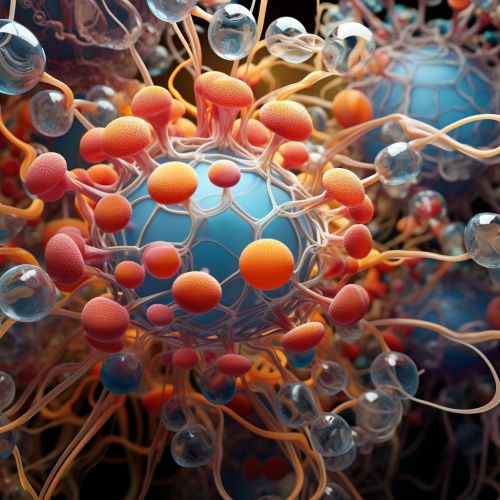Proteostasis
Overview
Proteostasis, also known as protein homeostasis, is a biological phenomenon that maintains the balance of proteins within a cell. It involves a complex network of processes that control the synthesis, folding, trafficking, and degradation of proteins. The proteostasis network (PN) is crucial for cellular health and function, and its disruption can lead to diseases such as neurodegenerative disorders, cancer, and aging-related diseases read more.


Protein Synthesis and Folding
Protein synthesis is the process by which cells generate new proteins. This process begins with the transcription of DNA into RNA, followed by the translation of RNA into a polypeptide chain, which is the primary structure of a protein read more. The polypeptide chain then undergoes folding to achieve its functional three-dimensional structure. Protein folding is a complex process that is facilitated by molecular chaperones, a group of proteins that assist in the folding and unfolding of other proteins read more.
Protein Trafficking
Protein trafficking, also known as protein transport, refers to the movement of proteins within a cell. After synthesis and folding, proteins are transported to their respective locations within the cell where they perform their functions. This process is facilitated by various proteins and complexes, including the endoplasmic reticulum (ER), the Golgi apparatus, and vesicles read more.
Protein Degradation
Protein degradation is the process by which cells break down and remove proteins. This process is crucial for maintaining proteostasis as it allows the cell to get rid of damaged or misfolded proteins that can be harmful. Protein degradation is mainly carried out by two systems: the ubiquitin-proteasome system (UPS) and the autophagy-lysosome pathway (ALP) read more.
Proteostasis Network
The proteostasis network (PN) is a complex system of processes and components that work together to maintain proteostasis. The PN includes the processes of protein synthesis, folding, trafficking, and degradation, as well as the various proteins and complexes that facilitate these processes. The PN also involves mechanisms that respond to changes in the cellular environment and adjust the processes of proteostasis accordingly, such as the unfolded protein response (UPR) and the heat shock response (HSR) read more.
Disruption of Proteostasis
Disruption of proteostasis can lead to the accumulation of misfolded or damaged proteins, which can be harmful to the cell. This can occur due to various factors, such as genetic mutations, environmental stress, and aging. Disruption of proteostasis is associated with various diseases, including neurodegenerative disorders, cancer, and aging-related diseases read more.
Proteostasis and Disease
The role of proteostasis in disease is a major focus of research in the field of cell biology. Many diseases are associated with the disruption of proteostasis, including Alzheimer's disease, Parkinson's disease, Huntington's disease, and various types of cancer. In these diseases, the accumulation of misfolded or damaged proteins can lead to cell death and tissue damage read more.
Therapeutic Approaches
Therapeutic approaches to restore proteostasis are being explored as potential treatments for diseases associated with the disruption of proteostasis. These approaches include the use of small molecules to enhance the capacity of the PN, gene therapy to correct genetic mutations, and cell therapy to replace damaged cells read more.
